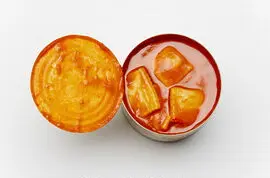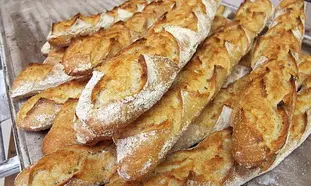This site uses only a few technical cookies necessary for its operation. By continuing to browse, you accept their use.
To find out more...
To find out more...
Let's go easy on the salt

In terms of cooking, I'm probably not teaching you much, salt is ubiquitous, we put it in almost all our dishes, in varying amounts depending on our taste, some like salty, others less, others still not. Its main role is the flavor, the taste, we say that it is a flavor enhancer, ie it reveals the tastes of food, especially if they are a bit bland by nature.
6,140 4.8/5 (19 reviews)
Keywords for this post:SaltHealthExcessWHOLimitationReductionLast modified on: February 20th 2021
Let's go easy on the salt
In other words, a dish that is not salty is much less tasty than a salty dish, and as a result, it is, for many (and I am the first), difficult to do without it.
But there are 2 salts, the one you add while cooking, or by spreading with semi-salted butter, according to your taste, and especially the one you don't see or don't feel, the hidden salt. And to illustrate this, I will take 2 concrete examples:
So when you heat up a simple box of ravioli, you will eat too much salt without realizing it, and as a recent study by "Que choisir" shows, it's even worse for anything that seems cheap, the less expensive the product is, the more salt it contains, so that the manufacturer can mask the poor quality of its ingredients.
But let's go back to salt, in France, the usual use (but it is not regulated, for the moment), is 18 gr of salt per kilo of flour. This is relatively little, to compare 50 years ago it was 24 gr, or even more!
The trend is clearly downwards, and the bakery industry is pushing for a reduction to 16 or 14 g, or even less.
Moreover, there is a simple phenomenon linked to slow bread-making: the longer the dough rests and ferments, the less salt it needs. And so the express baguettes from the supermarkets or bread factories, imagine what they load in salt to try to sell you something that has a vague taste.
Don't hesitate to ask your baker, ask him how much salt he uses per kilo of flour? If he's a good baker, not only will he give you a straight answer, but he'll also be able to give you his personal perspective on this delicate subject. By the way, our Belgian friends have a maximum of 14g.
Then, when we cook, we must try to avoid having a heavy hand in salt with extremely simple tricks too: always taste before re(salting), prefer spices to salt when possible, do not "double" that is to say for example do not salt a dressing, because it is already salty with the addition of mustard, no or little salt if you put cheese in your recipe, etc.
Nothing revolutionary in all this you will have understood, you just have to be a little careful, read carefully the labels of what you buy, and especially... cook as much as possible!
To sum up: Let's go easy on the salt, it's a matter of our health.

But there are 2 salts, the one you add while cooking, or by spreading with semi-salted butter, according to your taste, and especially the one you don't see or don't feel, the hidden salt. And to illustrate this, I will take 2 concrete examples:
Ready-made meals
The industrialists of the food industry have found in salt their best friend, not only they raise the taste as I told you previously, but moreover it acts as a water retainer, so everything that contains water, almost everything in fact, is generally very or too salty. Tragically, there is a lot of it everywhere, in all ready-made meals, cold cuts, snacks... even sweet foods (creams, desserts, biscuits, etc. etc.) contain it.
So when you heat up a simple box of ravioli, you will eat too much salt without realizing it, and as a recent study by "Que choisir" shows, it's even worse for anything that seems cheap, the less expensive the product is, the more salt it contains, so that the manufacturer can mask the poor quality of its ingredients.
Bread
In bread, there is also salt, bread is extremely simple: water, flour, a little salt and yeast or leaven, period! Everything else, as JP Coffe rightly said, is crap, just there to compensate for the deficiencies of industrial bread.
But let's go back to salt, in France, the usual use (but it is not regulated, for the moment), is 18 gr of salt per kilo of flour. This is relatively little, to compare 50 years ago it was 24 gr, or even more!
The trend is clearly downwards, and the bakery industry is pushing for a reduction to 16 or 14 g, or even less.
Moreover, there is a simple phenomenon linked to slow bread-making: the longer the dough rests and ferments, the less salt it needs. And so the express baguettes from the supermarkets or bread factories, imagine what they load in salt to try to sell you something that has a vague taste.
Don't hesitate to ask your baker, ask him how much salt he uses per kilo of flour? If he's a good baker, not only will he give you a straight answer, but he'll also be able to give you his personal perspective on this delicate subject. By the way, our Belgian friends have a maximum of 14g.
And so?
The observation is without appeal, we eat too much salt, we should be at 5 gr/day maximum according to the WHO, and we are rather at 10/15 gr in France.What can we do?
The solution is almost too simple: first of all, we must try to limit all ready-made products, which is often easier said than done. Let's see this as a strong signal to push us to cook more and more ourselves, by transforming the products we buy locally. The virtuous circle I've already told you a lot about (yes, it's my hobby): we buy local even if it's a bit more expensive, we support local producers, they produce well and healthily, it's good for our health, everyone wins.Then, when we cook, we must try to avoid having a heavy hand in salt with extremely simple tricks too: always taste before re(salting), prefer spices to salt when possible, do not "double" that is to say for example do not salt a dressing, because it is already salty with the addition of mustard, no or little salt if you put cheese in your recipe, etc.

Nothing revolutionary in all this you will have understood, you just have to be a little careful, read carefully the labels of what you buy, and especially... cook as much as possible!
To sum up: Let's go easy on the salt, it's a matter of our health.
Lasts posts
Always secure your cutting board
When using a cutting board, it's very important that it's stable and doesn't move while you're cutting, for safety's sake. Boards have a natural tendency to slide on the work surface, but here are 2 ways to block them effectively.July 1st 20255505
Cherry clafoutis, with or without pits?
When it comes to cherry clafoutis recipes, there's often a camp of those who argue that you absolutely have to leave the stones in because it tastes better, and the other camp (myself included) who prefer cherries without stones, which makes a much more pleasant clafoutis to eat. But is it true...June 29th 20256885
Should potatoes be washed twice?
Let's say you have to make a recipe that includes potatoes, let's say sliced, you'll most likely proceed as follows: Peel the potatoes, wash them, slice them, wash them again, pat them dry and add them to your recipe. But there's a "but": depending on the recipe, the second washing may be a bad...May 19th 20252,297 15
Grilled bacon is much better in the oven
Some recipes call for thin slices of bacon to be cooked and added to the recipe, or to prepare one of those delicious breakfasts known as "à l'Anglaise".April 25th 20252,0575
The thermometer is your friend
There are many recipes or foods that require a (very) precise cooking temperature: foie gras, sugar for caramel, meats and fish, and not forgetting pastries. For these few examples, getting the cooking temperature wrong can spoil the whole recipe or dish: undercooked, it's no good or misses the...April 10th 20252,3775
Other pages you may also like
For well opened (puffed) cakes
It's always nice to have a well puffed up cake after baking, not only will it taste good but it looks great too. Let's see how to get this beautiful shape almost every time.January 23th 201930 K4.2
What is the difference between bakery and patisserie?
This is a question that you may well have asked yourself and which I will attempt to answer. In France the two trades of "boulangerie" (bakery) and "pâtisserie" (patisserie and confectionery) have always been quite distinct, but where exactly do the boundaries lie? .February 7th 2017129 K 14.1
Drawing a pattern in pastry
Often in the kitchen, in pastry-making, or in baking, we need to trace a pattern on a pastry. It's just a question of aesthetics but it has its effect after baking on a galette, pithiviers, pâté en croute (terrine in a pie crust), etc.May 23th 201931 K4.1
The "caves" in the bakery and pastry shop
Maybe you've already done this? You want to make a brioche or a cake with fruit inside, you decide to proceed with your usual recipe, but also to add in the dough pieces of fresh and raw fruit, or whole fruit, for example pieces of apples or pears, good idea. When you bake it, everything seems to...March 27th 20219,1244.9
The so-called "nervous" meats
You've probably heard this before, we're talking about "nervous" meat, or meat with nerves, to describe what is indicated by the blue arrow on the left. This is a piece of beef, and what we call a nerve is not a nerve, it is in fact collagen (chemists sometimes call it a "collagen sink"), a...April 16th 202131 K4.5
Post a comment or question
Follow this page
If you are interested in this page, you can "follow" it, by entering your email address here. You will then receive a notification immediately each time the page is modified or a new comment is added. Please note that you will need to confirm this following.
Note: We'll never share your e-mail address with anyone else.
Alternatively: you can subscribe to the mailing list of cooling-ez.com , you will receive a e-mail for each new recipe published on the site.









